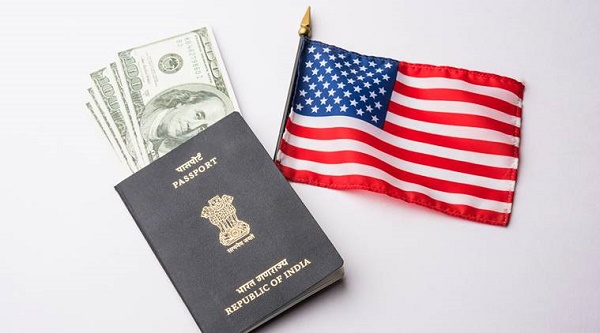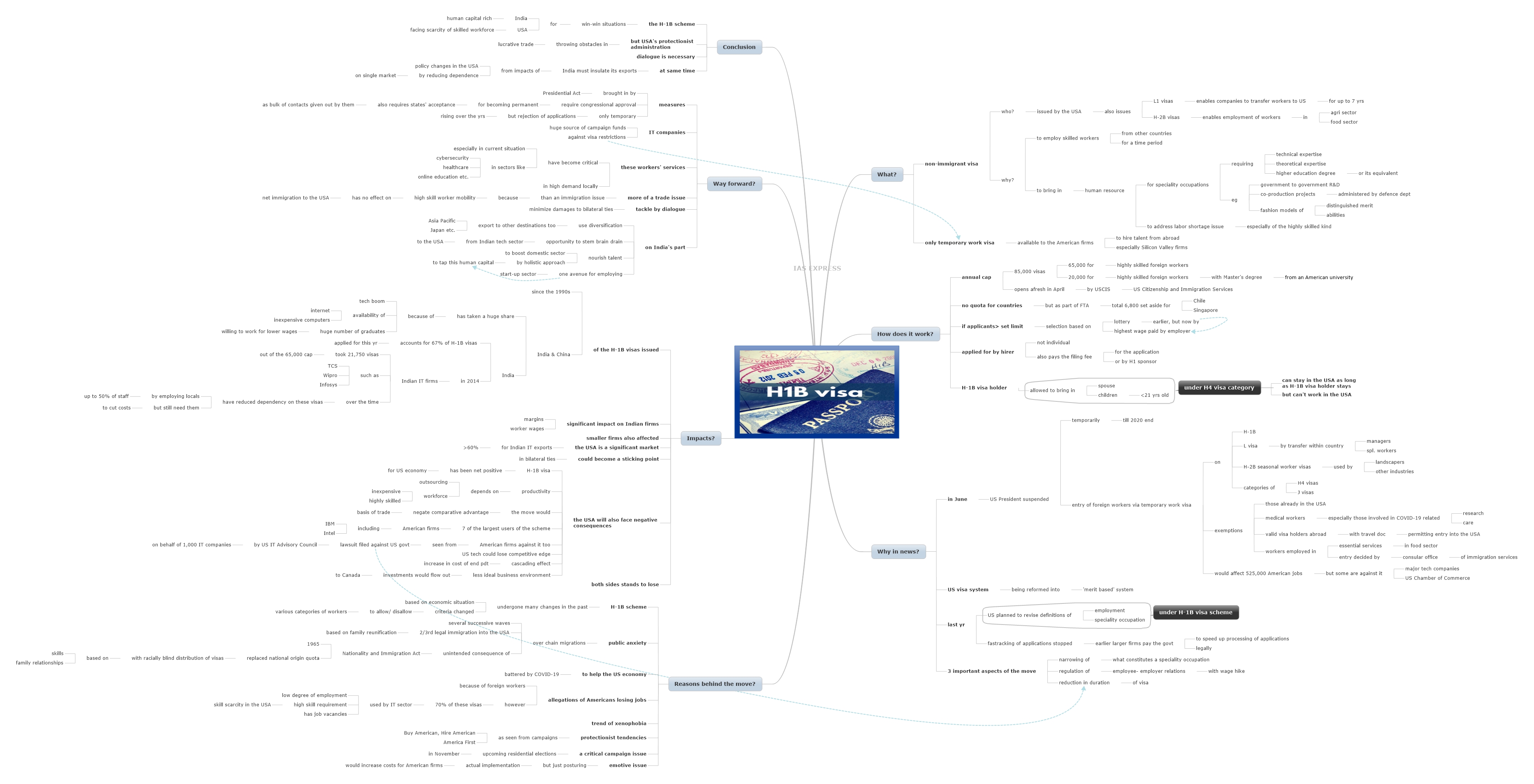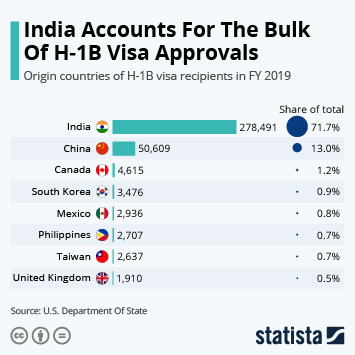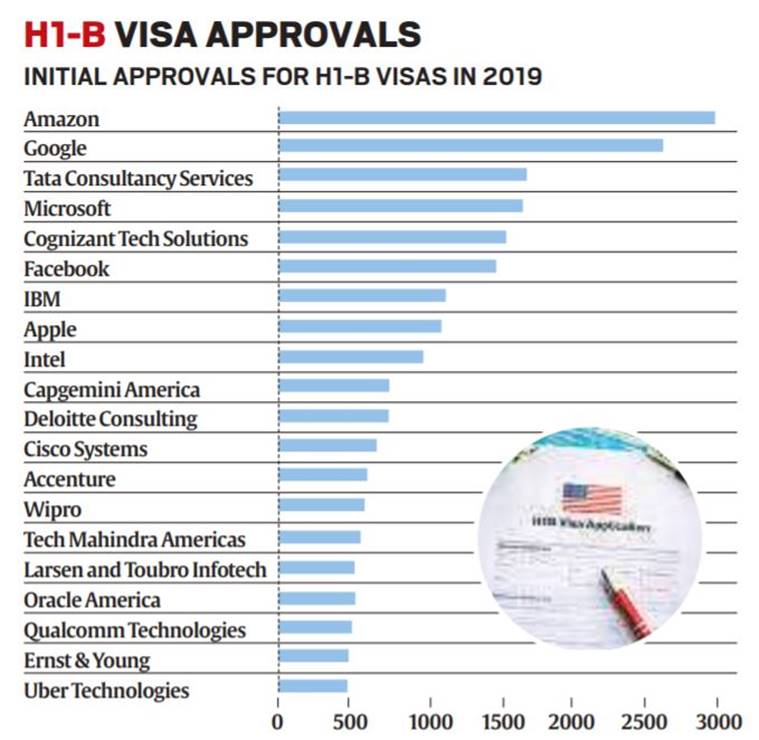H-1B Visa Issue- All You Need to Know

Despite strong opposition from business groups, the US President, in June, suspended the entry of certain foreign workers on temporary work visas into the USA. It is perceived as only the latest effort by the US administration to bar the entry of immigrants into the country.
This topic of “H-1B Visa Issue- All You Need to Know” is important from the perspective of the UPSC IAS Examination, which falls under General Studies Portion.
What is H-1B visa?
- It is a non-immigrant visa issued by the USA to employ skilled workers from other countries for a certain time period.
- It is used for bringing in human resource for speciality occupations requiring theoretical or technical expertise.
- Such occupations require a higher education degree (or its equivalent). These include government to government R&D, co-production projects administered by the defence department and fashion models of distinguished merit and ability.
- It is the only temporary work visa available to the American firms to hire talent from abroad. It is of special significance to the Silicon Valley firms.
- It was intended to address the labour shortage problem faced by the American firms- especially of the highly skilled but low cost labour.
- Apart from this, the US government also issues L1 visas which enables companies to transfer workers to US for up to 7 years and the H-2B visas which enables employment of workers in food and agricultural.
How does it work?
- The government has a cap of 85,000 H-1B visas per year. 65,000 of this are issued to highly skilled foreign workers and the rest (20,000) are issued to highly skilled foreign workers with a Master’s degree (or a higher education degree) from an American university.
- There isn’t any quota for any country. However, as a part for free trade agreement, a total of 6,800 is set aside for Singapore and Chile.
- If the number of applicants is higher than the limit set, a lottery is conducted to decide. However, this was changed by the recent revision of norms. According to the new norms, highly skilled workers who are paid the highest wages by their employers will be favoured.
- The cap for the H-1B visa application is opened afresh in April, each year, by the US Citizenship and Immigration Services (USCIS).
- Individuals cannot apply for this visa- only the hiring firm can do so. The filing fee for the visa is paid by the employer or the H1 sponsor.
- An H-1B visa holder is allowed to bring their spouse and children (under 21 years of age) to the USA under the H4 visa category.
- The H4 visa holder can stay in the USA as long as the H-1B visa holder stays.
- However, unlike the H-1B visa holders, H4 visa holders cannot work in the USA.
Why is it in the news?
- In June, 2020, the US President issued a proclamation to extend the temporarily block, on the entry of foreign workers on the H-1B visa, till the end of 2020.
- The proclamation also suspended the entry of managers and specialized workers being transferred within a company- via L visas.
- In addition to this, the US President also blocked the entry via H-2B seasonal worker visas used by landscapers and other industries.
- Certain categories of H-4 and J visas are also to remain suspended till the year-end.
- Exceptions to this order are those already in the USA and medical workers, especially those involved in COVID-19 related care or research.
- Valid visa holders abroad, with appropriate travel documents permitting entry into the USA, are also exempted from the order.
- Reprieve has been given to workers in essential services in the food sector as their entry is to be decided by the consular office of immigration services.
- Meanwhile, the entire US visa system itself is being reformed into a ‘merit based’ system.
- Though the White House claims that the restrictions would affect 525,000 American jobs, major tech companies and the US Chamber of Commerce are against it.
- Last year, US planned to revise the definition of ‘employment’ and ‘speciality occupations’ under H-1B visas.
- Earlier larger firms were able to fast-track their H-1B visa application by paying the government (legally). This fastracking of applications was also stopped.
- There are 3 important aspects to the move:
- Narrowing of what constitutes a speciality occupation.
- Regulation of employee- employer relations with a hike in wages.
- Reducing the duration of the visa.
What is the reason behind the USA’s move?
- The H-1 visa scheme has undergone many changes since its introduction. Over the time, depending on the economic situation, the criteria have been changed to allow or disallow certain categories of skilled workers into the country.
- One of the reasons for the move is the public anxiety in the USA over successive waves of ‘chain migration’. Almost 2/3rd of the legal immigrations into the USA is based on family reunification.
- This chain migration is an unintended consequence of a 1965 law- the Nationality and Immigration Act. This act brought in racially blind distribution of visas– replacing the earlier national origins quota. The distribution of the visas, under this act, is based on skills and family relationships subject to caps for each country.
- According to the White House, the move would help the US economy which has been battered by the coronavirus pandemic.
- There have been allegations that the American workers are losing jobs because of foreign workers. On this point, it can be noted that a bulk of this visa (70%) is used by the IT sector, which has an already low degree of employment and high skill requirement. There are still job vacancies in the sector.
- One of the reasons why tech firms in the USA started employing foreign workers on H-1B visas is the skill scarcity in the domestic workforce. Hence the argument of jobs being lost to foreign workers isn’t valid.
- There is a trend of xenophobia in the USA and the pandemic is simply being used as cover to harden the legal immigration channels.
- Their protectionist tendencies are also reflected by how the campaigns like ‘Buy American, Hire American’ and ‘America First’ are gaining currency.
- Moreover, this is a critical campaign issue with both the parties in the last presidential elections focusing on it. In light of the upcoming presidential elections in November, the motive behind the push for hardening the visa channels could be understood.
- However, this is an emotive issue and the recent moves are seen by experts as posturing. This is because, many of the IT firms are against the move- claiming it would increase costs for them and at the end of the day, the biggest loser will be the economy.
How will it impact India and the USA?
- A lion’s share of the H-1B visas issued since the 1990s has been cornered by Indian IT companies. This is a result of the tech boom coupled with the introduction of the internet and inexpensive computers in countries like India and China. A huge number of graduate from these countries were willing to work for lower wages in the USA.
- As of April this year, according to the USCIS, India accounts for about 67% of the total H-1B visa applications in the current fiscal year.
- In 2014, Indian IT companies accounted for 21,750 visas out of the total 65,000 cap. Firms like TCS, Wipro and Infosys are among the major users of H-1B visas.
- Over the time, large IT companies (of Indian origin) have reduced their dependency on these temporary worker visas by hiring as much as 50% of their staff from among the locals. Yet, these visas are essential for these firms to keep costs in check.
- Changing the H-1B norms will have significant impacts on the worker wages and the margins of Indian IT firms that deploy thousands of its employees to work on client sites in the USA.
- It is not only the larger firms that will be affected by these moves, smaller IT companies will also be affected.
- India exports significant quantities of software services to USA. Over 60% of India’s software exports is to the USA.
- This could become a sticking point in the India-USA bilateral ties.
- However, it should be noted that the USA itself will face negative consequences from the move as the H-1B visa has been net positive for US economy.
- This is because productivity in the USA, especially in the tech sector, depends on outsourcing and inexpensive but highly skilled workforce. The move would negate the comparative advantage– which is the very basis of trade.
- Also, it isn’t only the Indian IT firms in the USA that benefit from the H-1B visa scheme. American tech giants like IBM and Intel depend on this route too. 7 of the largest users of the H-1B visa scheme are American firms.
- Hence, even the domestic firms are against the move. This is evident from the US IT Advisory Council, on behalf of a 1000 IT companies, filing a lawsuit against government for issuing H-1B visa for less than 3 years.
- The American tech sector is in danger of losing its competitive edge if its access to inexpensive but highly skilled labour is impeded.
- Though these measures would increase the employment of more locals, a cascading effect is expected and could result in increase in cost of the final products from these sectors.
- The business environment in the USA would become less ideal and investments could flow out to adjacent Canada. The US Chamber of Commerce had even termed these restrictive measures as ‘a gift to Canada’.
- End of the day, both sides stands to lose out.
What is the way forward?
- These measures were brought in by Presidential Act. These require congressional approval for made permanent.
- It is noteworthy that IT companies are a huge source of campaign funding and the Silicon Valley has been against the restrictions on H-1B visa route. More permanent measures are not expected to be brought in in the near future. Even if such measures were introduced, bulk of the contracts are given out by the states. So if it has to come into effect, the states have to pass it.
- Over period, the services of these foreign workers have become critical in several sectors, especially in the current situation- like online education, cybersecurity, healthcare, etc.
- Hence, this is more of a trade issue than an immigration issue- especially as high skill worker mobility does not affect the net migration numbers to the USA (or any other country).
- Though these measures are temporary and are seen mainly as posturing for the upcoming elections, it is to be noted that the H-1B applications’ rejection levels have been rising over the years.
- The current issue is best tackled by dialogue. There is a need to minimize the damage to bilateral ties.
- On India’s part, diversification is a key way forward. This process has already been set in motion as more and more IT services are being exported to other destinations like Asia Pacific, Japan, etc. These highly skilled workers are in high demand
- The American tech industry has been draining a huge portion of talent out of India over the years. The current moves could actually be an opportunity for India to stem the brain drain.
- Nourishing these talents in India would boost the domestic tech sector. A holistic approach is required to tap into this human capital.
- One of the avenues for employing this human capital, made available by the H-1B visa restrictions, is the start-up sector. The infusion of talented and experienced workforce into the sector will boost its performance.
Conclusion
The H-1B visa scheme created a win-win situation for India with rich human capital and the USA with scarcity of highly skilled but inexpensive workforce. Over the years, the advent of more protectionist administration in the USA has thrown obstacles in this lucrative trade. Dialogue is necessary to keep the damages to bilateral ties to a minimum. At the same time, India must look to insulate its exports from impact of policy changes in the USA by reducing dependence on a single market.
Practice question for mains
The H-1B visa issue between India and USA is more of a trade issue than an immigration issue. Comment. (250 words)
https://www.youtube.com/watch?v=OsBbVYti6Os
https://www.youtube.com/watch?v=UG5mnvyd7Cw
https://www.youtube.com/watch?v=A7rvtQFOD54
https://indianexpress.com/article/explained/donald-trump-immigrant-visa-india-impact-6488194/
https://www.youtube.com/watch?v=akIXBiBddUU
https://indianexpress.com/article/explained/us-h1b-visa-suspension-india-it-companies-6471966/





